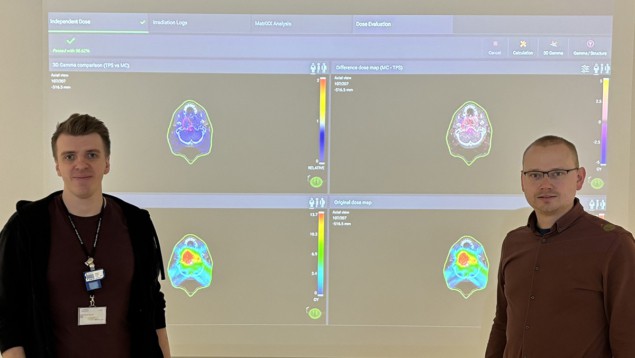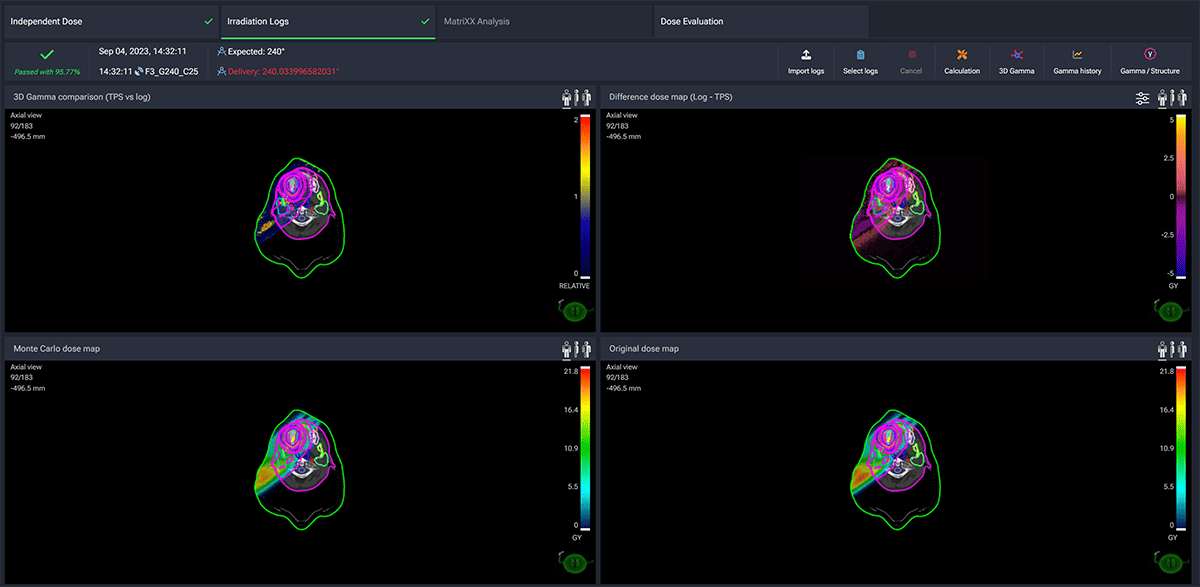Calculating the dose distribution from the data recorded by the treatment machine could deliver faster and more accurate dose verification than existing measurement-based approaches

According to Arturs Meijers, head of Clinical Medical Physics at the Paul Scherrer Institute (PSI) in Switzerland, proton therapy is at the cusp of a paradigm shift that could transform the way that treatment plans are verified before they are delivered to a patient. Instead of the current measurement-based regime for patient-specific quality assurance (QA), independent dose calculations that check the quality of the treatment plan and ensure that it is delivered as intended would offer a speedier solution that also has the potential to improve quality control.
“In proton therapy we want to transition away from measurement-based techniques for patient-specific QA, since it takes a lot of time and often creates a bottleneck in the treatment delivery room,” Meijers explains. “A solution that verifies the delivery of the treatment plan by reconstructing the dose from the log files could provide a QA process that is at least equivalent but in principle even better than what we have now.”
PSI’s current protocol for patient-specific QA, in common with most proton therapy centres, is to measure the dose delivered by the proton beam using a detector array, with a water-like phantom acting as a surrogate for a human patient. Measurements recorded at one or more depths in the phantom can then be compared with the dose distribution in the treatment plan, but this time recalculated for an equivalent water cube.
The big problem with this approach is the time needed to take the measurements, which also reduces the availability of the therapy suite for treating patients. But it also has several limitations for achieving proper quality control. “All the comparisons are made using very simple geometries and calculations that are based on water,” says Meijers. “A number of studies suggest that this measurement-based approach can miss potential issues, and might not always catch any errors that arise in the treatment planning simulations.”
Integrating the data
Through a collaboration with IBA Dosimetry, Meijers and his team at PSI are now testing whether a software-based solution that recalculates the delivered dose from the treatment log files could offer a better solution. Importantly, the PSI team has also worked with Varian to extract the treatment log files from its ProBeam machine for proton therapy, then convert them into the standard DiCOM format that is used by IBA’s myQA iON platform for patient-specific QA.
“This is one of the first demonstrated integrations of myQA iON with the log files from the ProBeam machine,” says Meijers. “It’s one thing to have access to the information, but quite another to interface the specific file formats used by different system vendors with other software applications. These non-standard processes for accessing and using information is one of the key challenges for progress in the field.”
Now that the integration is complete, the PSI team is starting to use the log-file data within myQA iON to reconstruct the dose distribution from the actual delivery sequence provided by the machine. “During the treatment process there is a lot of data exchange between different subsystems, and there is always a risk that information can be misinterpreted or the data become corrupted,” explains Meijers. “By reconstructing the dose from the log files we can check the integrity of the data across the entire workflow, all the way from the treatment planning system to the delivery of the beam.”
Within IBA’s myQA iON platform it is also possible to verify the initial patient plan created in the treatment planning system against an independent dose calculation produced using the Monte Carlo method. This simulation technique treats the millions of interactions generated by the proton beam in a probabilistic way, providing the most accurate method for calculating the dose distribution across a full 3D volume. “Using this two-step QA process we can verify the quality of the original treatment plan and check that the information has not been compromised by the time we get to the delivery of the treatment,” adds Meijers.
A gradual transition
To evaluate the performance of this new QA process in a clinical setting, the PSI team is now running the software-based solution in parallel with its existing measurement-based techniques. “Before we make the transition we want to baseline the new method against our established processes,” says Meijers. “Recalculating the dose from the log files does not add much overhead, so we will run both workflows for at least a few months to gain confidence in the performance and behaviour of this new approach.”
While it is too early to be certain that the software-based solution matches or improves on the level of quality control provided by a measurement-based regime, Meijers can already see the potential to dramatically reduce the time needed for patient-specific QA – both in terms of manpower and the use of the therapy suite. Currently it might take 30 minutes to take the measurements needed to verify the treatment for each patient, while myQA iON can recalculate the dose from the machine data within a matter of minutes.
“With this process you can pretty much eliminate the need to book the treatment room for taking measurements,” says Meijers. “However, in practice we are unlikely to switch completely from one workflow to another, It will be more of a gradual transition where we tune down the number of measurements over time.”

To support this hybrid approach myQA iON provides an easy way for medical physicists to review the results from different dose verification methods. The original patient plan can be imported from the treatment planning system to enable comparison with the independent Monte Carlo calculations, while measurement datasets can also be uploaded to check against the dose distribution that is reconstructed from the treatment log files. Combining all of this verification information in a single web-based system also ensures that everyone in the clinical team can access the most up-to-date information from any computer in the treatment centre.
Meijers believes that recalculating the dose from the machine data could be particularly beneficial for verifying treatment modalities based on pencil beams, in which a very narrow proton beam is scanned across the tumour volume. “From the treatment log files we can calculate the amount of dose delivered by the beam to each spot position,” he says. “These actual delivery sequences give us more information about the dose distribution than we get from a high-level measurement of a dose plane in a simulated water cube.”
Indeed, there is a clear mandate for change within the proton therapy community. Work within the Particle Therapy Co-Operative Group (PTCOG) has been analysing the treatment and workflow efficiencies for different approaches to patient-specific QA, and has concluded that recalculating the dose from the log files offers greater value for quality control than the conventional measurement-based methodology. “It’s important to demonstrate that this new approach is not just making our lives easier, but that the level of quality control it provides is at least equivalent to current techniques and preferably even better, says Meijers. “We certainly don’t want to make our QA processes less robust, or introduce methods that may not be able to detect certain issues.”
Eliminating the need for measurements will also be crucial for the introduction of adaptive treatment protocols, in which the treatment plan is updated to account for the changing anatomy of the patient. A software-based solution would allow the new treatment plan to be independently checked without the need for additional measurements, potentially allowing the updated plan to be delivered while the patient is still in position.
In the short term, however, the main motivation for Meijers is to maximize the amount of time that the therapy suite is available for treating patients. “For facilities that are fully booked or close to capacity, patient-specific QA is one of the main bottlenecks,” he says. “By making our workflows more efficient, this approach can increase the number of fractions that are delivered each day and increase the treatment capacity of the facility.”
- SEO Powered Content & PR Distribution. Get Amplified Today.
- PlatoData.Network Vertical Generative Ai. Empower Yourself. Access Here.
- PlatoAiStream. Web3 Intelligence. Knowledge Amplified. Access Here.
- PlatoESG. Carbon, CleanTech, Energy, Environment, Solar, Waste Management. Access Here.
- PlatoHealth. Biotech and Clinical Trials Intelligence. Access Here.
- Source: https://physicsworld.com/a/proton-therapy-enters-a-new-era-of-efficiency-with-a-software-driven-qa-solution/



